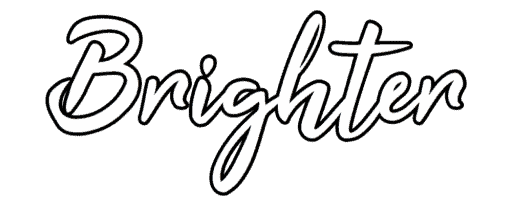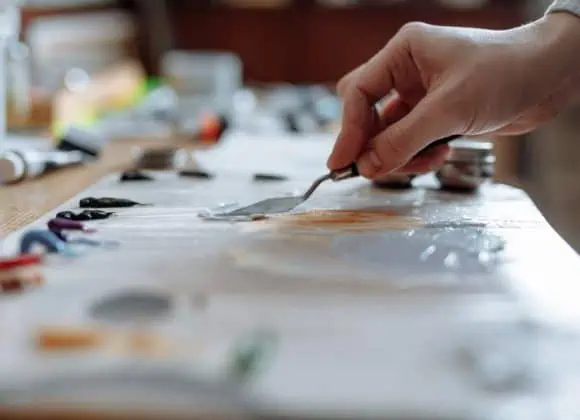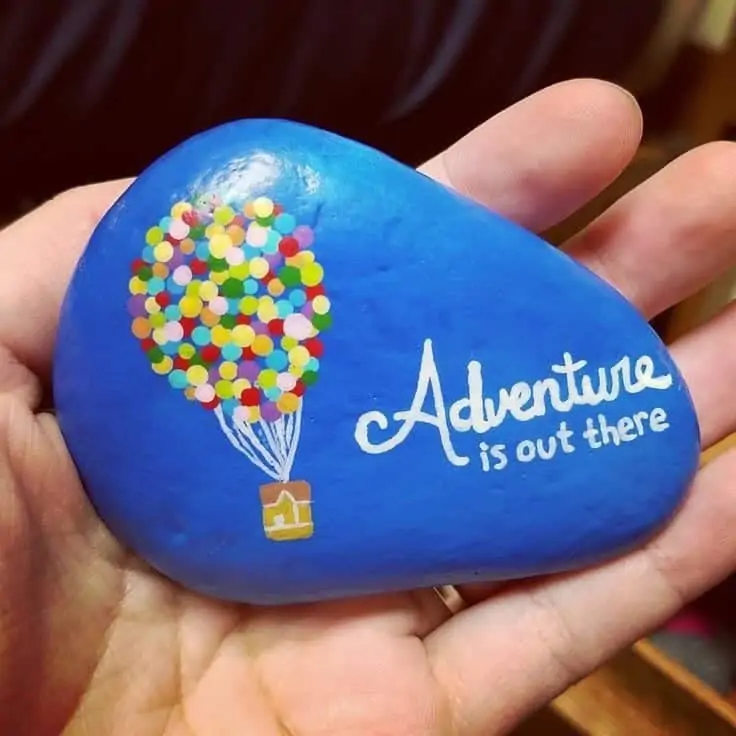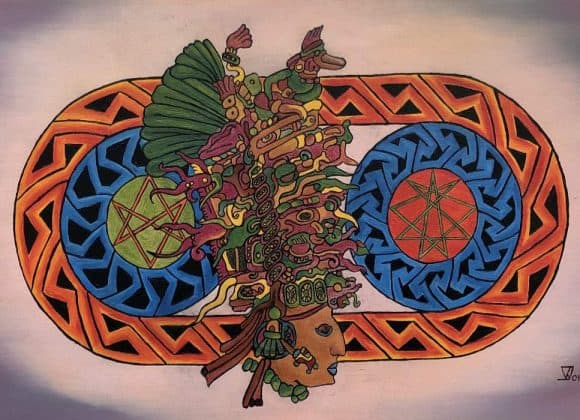Sage green is a very specific kind of green and has much more white in than most greens. It is a cool green with more blue in the paint mix too. Green is always made by mixing blue and yellow paint, but for sage green you want cool colors to make the right color mix.
If you use Cobalt Blue and Lemon Yellow for the base color you will need more blue and less yellow than most greens you mix, but you will need to add white too. Titanium white is one option but it is a high pigment color and so I tend to use Zinc White instead. It makes getting the proportions right much easier.
A darker Prussian Blue can be combined with Lemon Yellow too. You will need less blue that way as Prussian blue is a dark high pigment color. Naples Yellow is another option, It is an earthy yellow that already has a proportion of white pigment in the color mix.
Table of Contents
Try different combinations
Try some different combinations to get the exact color you need. Any green is a secondary color so you have a wide variety of tones and colors you can create. Yellow Ochre will warm the green up a little for highlighted areas, especially in the foreground. Prussian blue or possible even Payne’s Grey will help you when mixing the Darker tones for shadows.
If you look carefully at a landscape painting where Sage green is used you will see different tones not just one green, so think about the main color you need as the one that is the most common in the picture. A little Prussian blue will help you get the darker tones and adding a little more Zinc White will give you the lighter tones you need.
Make a Sage Green paint chart
Making a Sage Green color chart will help you understand the effect of combining different colors. Use a selection of cool primary blue colors like Cobalt Blue, Prussian Blue and Pthalo Blue to start with. Lemon yellow, Yellow Ochre or Naples Yellow are usually the best yellows to start with too. You will need to add white to some of the combinations to get the color you need though.

Combining these colors to make green will give you cool greens. Depending on how much blue or yellow you use, the colors you create will be different but they will all be cooler than greens mixed using Chrome yellow or Cadmium Yellow.
Creating a chart to document the differences will help you understand how each primary color affects the final mixed color. That understanding will make mixing the right color much faster in the long term.
Authors note
Please note, the colors in the chart are representative. Computers will render them according to set up so the colors will vary from one screen to another. The idea is to give you an idea of the different effect that mixing slightly different colors can have on the mixed color.
Mixing green with acrylic paints
Acrylic paint dries quickly, so you’ll have to work faster than with other types of paint. Mix a Sage Green base color first with Cobalt Blue, Zinc White and Lemon Yellow. After that you can fine-tune the exact colors you want on the painting itself. Don’t forget to keep some clean water handy. You will need it for mixing colors and to wash your brush when you’re finished.
Adding thin washes of the Zinc White will lighten the tone and a thin wash of dark blue, dark grey or even Burnt Umber will help you get the color of the shadows. Water the washes of acrylic paint down until they are very thin and add them little by little. Dry brushing with similar tones can also help, don’t be frightened to use both techniques if needed. Just make sure the paint underneath is dry before you try to apply any dry brushing.

Mixing Sage Green with oil paints
Oil paint stays wet for longer so it is easier to mix. Mix a chart to help you, just use primed paper. Put a blob of each color of oil paint on each square of the chart, clean your brush and then blend the colors in each square together. Keep your brush clean before starting to mix each new color on the chart.
Something else you can try is to run a thick line of blue oil paint across the top of a page with a palette knife. Put a blob of yellow in the left bottom corner and then a blob of Zinc White in the right bottom corner.
Scrape areas of the blue down until you have an uneven layer of blue paint over the upper half of the paper. Then clean the palette knife and spread the yellow towards the centre of the page. Then do the same with the Zinc White. Where the colors get close to each other just mix them. Blend them in different ways and you will begin to see the variety of colors you can mix.
Blend the colors smoothly with a fan brush, or you can mix them roughly, leaving streaks of the original colors as well as the color you are mixing. You can add different amounts of each color and mix them in a small area, then work that paint into the other colors you have mixed to adjust the tone again.
Mixing color gradients with oil paints
Similar to how we did above take a palette knife and put a blob of Naples Yellow and Cobalt Blue on a primed piece of paper, then put a smear of white across the top of the page and a smear of Prussian Blue across the bottom. Mix the yellow and blue across the middle roughly to begin with and spread the colors gradually out towards the white and Prussian Blue.
Study the different colors you create and you will begin to learn how each color affects the exact hue of the Sage Greens that you have mixed.
Blend in the white and Prussian Blue to create a complete tonal range for the Sage Green color you mix.
You can do similar with watercolors and acrylic paints. Creating gradients of color will help improve your color control. Understanding the tonal changes will help you mix the exact colors you want much easier as you learn.

Mixing Sage Green with watercolors
Remember that with watercolor painting the paper gives you the white you need. Don’t add too much pigment at the beginning.
You can mix the paint on the paper if you prefer, but I tend to mix a light base color on my palette a little first. Then I can work from that color and darken it where needed. Just don’t start with a pigment that is too dark.
Mix the tones with more water to begin with, then you can darken them gradually as you paint.
Don’t paint dark areas too big, or too quickly with a watercolor painting. It is difficult to lift paint off if it gets too dark.
If you do need to lift some paint off, you can use some kitchen roll. Dampen it thoroughly then squeeze out any excess water. Gently dab it onto the areas that are too dark and it will lift some of the color off the paper.
With watercolors it is easy to use thin washes. You can gradually adjust the tone as you paint. Adding a little Prussian Blue or Payne’s Grey will give you a dark enough color for any shadow. If you need more highlights you can use a little Naples Yellow, or maybe some white Guache. However, lifting some of the pigment off as described above is often the best solution. It will just leave more of the white from the paper showing through.
The close up of the painting below shows you how the multiple green shades and tones can work together to make each small part of a landscape painting come together.

Final thoughts
Sage Green is a striking natural green and if you paint landscapes you will likely need to mix it at some point. Earthy greens can create a totally different palette to the greens made using Metallic yellows like Chrome or Cadmium Yellow.
Naples Yellow can also be useful and is sometimes overlooked. It has a higher white pigment content than other yellows, so it will give you strong light tones.
Enjoy your journey discovering the beauty of Sage Green.
Try to understand the effects that the different blue’s and yellow’s have on the Sage Green colors you mix. As your ability improves you will find it easier to mix any of the colors you need easily and quickly.




